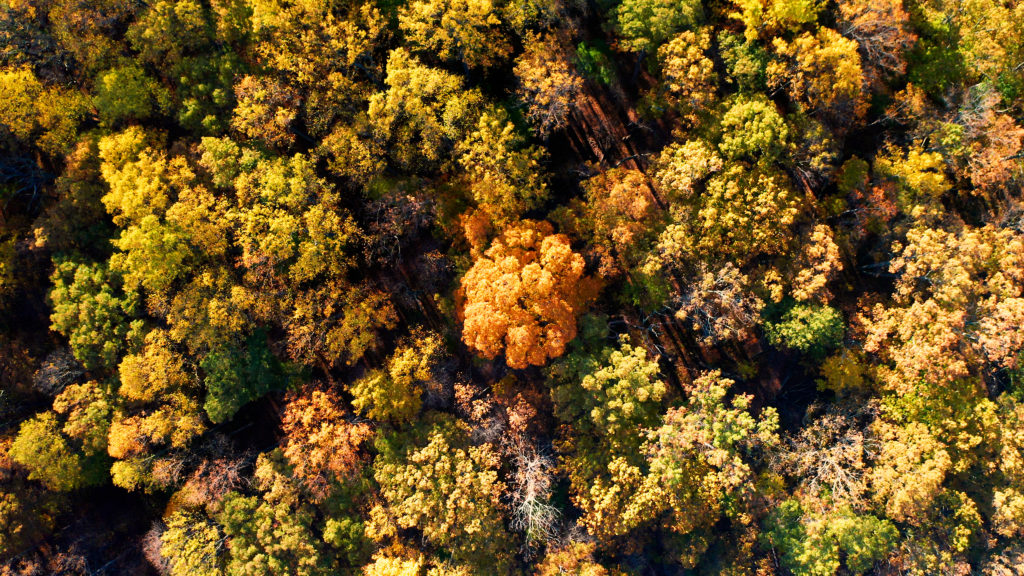
Dear Friends,
The vibrant colors of the forests this fall have been a source of inspiration and hope for thousands of residents and millions of visitors to the Piedmont region. Whether an individual tree with a complete crown in full display or the more complex patterns of a forested hillside, their effect is an awesome reminder of the power of the natural world to recenter our lives around a sense of place.
I cherish the time I spend each day walking through the woods near my home and the incredible views I get to experience driving as part of my work for PEC. These help me reconnect to nature and be present in the moment, while also giving structure and dimension to our work.
Recently, participating in PEC-sponsored forest buffer plantings in the Goose Creek and Upper Rappahannock watershed, where the collective efforts of hundreds of volunteers results in thousands of native trees along critical stretches of headwater streams, got me thinking about trees and forests and the importance of connecting the dots.
The collective efforts of hundreds of individuals and groups over 20 years has resulted in critical reforestation along stretches of headwater streams and cleaner drinking water for hundreds of thousands of Virginians across three counties.
As these trees grow and form an interconnected canopy, their impacts are multiplied. They represent the long-term push for improved water quality in all of our waterways and, ultimately, the Chesapeake Bay. They help retain precipitation, replenish our aquifers, and support clean drinking water. They also provide patches and pathways of habitat for critical wildlife migration and adaptation.
Much like the forests that flow down the slopes of the Blue Ridge and along the Piedmont region’s rivers and streams, scenic roads, and property lines, The Piedmont Environmental Council is a complex mosaic of programs and activities that, individually and combined, all contribute to better communities and an increasingly conserved and restored landscape.
As we accelerate specific programs to permanently conserve farm and forest lands, we are adding to the strong foundation of nearly 25% of the landscape already permanently conserved—close to 430,000 acres. At the largest scale, we are working to protect thousands of additional acres of forest along the Blue Ridge and throughout our region, where we can plant new forests, improve management of existing forests, and ensure we are contributing to the Chesapeake Bay Program goal of riparian forest buffers along 90-95% of our stream and rivers. By replacing invasive and non-native plants with native trees, shrubs and other vegetation, we both increase habitat and address climate change challenges such as potential for drought, increased flooding from more violent storms, and the health impacts of the heat island effect.
At the same time, our smaller-scale projects highlight and commemorate important aspects of our region—from the urban/suburban Larson Native Plant Garden to the more rural Roundabout Meadows and the Piedmont Memorial Overlook, to stream restoration along Bolton Branch and public access to the Rappahannock River. Each is a chance to use native trees and plants to demonstrate their potential in more sustainable landscape design and to balance design for visitors with habitat for wildlife and climate mitigation. We are grateful to work with leading experts and local garden clubs.
The hope and solace that autumn foliage inspires is a welcome counterpoint to the tough challenges and complex choices facing our communities, from rapid shifts in the real estate market, to growing demand for land and pressures for development, to the changing energy landscape—each influenced by the pandemic, climate change and more. One hopes that we can see both the forests and trees as valuable to our collective future, critical to long term resiliency in the face of real change.
Sincerely,
Chris Miller, President
This letter appeared in The Piedmont Environmental Council’s member newsletter, The Piedmont View. If you’d like to become a PEC member or renew your membership, please visit pecva.org/join.
